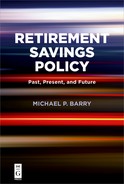Chapter 32
The Bureaucratization of Capital
But what would such a provider-dominated retirement savings world look like from the other end of the retirement savings process: how would it affect our capital markets?
Contemplating a provider-based solution—and the possibility of new and comprehensive provider-based regulation (e.g., a provider-based ERISA)—raises another and less felicitous vision: the bureaucratization of capital.
Think about that number from ICI we cited above—there is more than $27 trillion in US retirement assets. Private sector DB and DC plans—the plans we’ve been talking about in this book—have nearly $11 trillion of that. Consider: according to SIFMA, total US stock market capitalization is $27.4 trillion.
Retirement assets (not all invested in stocks, obviously) make up a huge percentage of our capital markets.
How did that happen? That’s what the last 200 plus pages of this book have been about—the transformation of retirement policy from one of transferring money between generations to one of transferring money across time—by saving and investing it. All of those savings and investments go into our capital markets and are allocated, by literally tens of thousands of firms and individuals, to American enterprises. These retirement savings represent a significant part of the rocket fuel that drives our economy. And, in that regard, let’s note that total US GDP is $18.6 trillion.
The diversity of our capital markets ecosystem can be regarded as a problem. It’s complicated. Inconsistent. The variety of investment firms and investment advisers and online utilities give contradictory advice. And many of them charge too much for their services—or at least, arguably, they could provide those services much more efficiently (and inexpensively).
If you asked most ordinary savers if they would like to go to a single payer system—where, for instance, they simply turned their savings over to a government-picked board of experts to invest and got a consistent if modest return—they would probably (enthusiastically) say yes.
One of the more fanciful proposals as a solution to covering the uncovered has been to give them all “access” to the federal government employees’ Thrift Savings Plan, where exactly that would happen: a government picked board of experts would invest their savings.
That might be a really efficient solution. And it doesn’t have the great problem that single-payer health care does. People don’t have a “personal relationship” with their broker.
But think what it would do to our capital markets. One of the great risks of going to a provider-based system mediated, e.g., by massive Open MEPs, is that it would radically reduce the diversity—and resilience and robustness—of our capital markets. This feature of our current system, in my humble opinion, outweighs all its costs.
This issue—this possibility, that with a retirement policy decision we will increase the bureaucratization of American capital markets—comes up whenever we don’t have someone making an active decision about how to invest retirement savings: What do we do with a missing participants’ money? What do we do with small account cash-outs? What do we do with the savings generated by, e.g., an auto-IRA (with respect to which it is likely to be common there will be no participant investment instructions)?
The answer to each of these questions seems easy: something along the lines of Warren Buffet’s answer to a question about what he would tell his widow (in the theoretical event of his death): put your money in a low-cost S&P 500 index fund.70
Just to be clear (if there’s any confusion): there are only 500 companies in the S&P 500. We cannot invest all $11 trillion of our retirement savings in just 500 companies. That idea is kind of ludicrous.
This issue also lurks in the widespread academic criticism of investment fees, which we considered back in Chapter 21. The attacks academics make on active management fees frequently compare these funds’ fees and performance to what it costs to invest in an S&P 500 index fund and S&P Index performance. The latter has, in fact, been pretty amazing since the 2008 financial crisis. But, as they say in mutual fund prospectuses, historical performance is no predictor of future performance.
Think about it. To the extent we have governments, or government picked boards of experts, investing these huge sums of capital, we run a set of very scary risks: the politicization of the allocation of $11 trillion in investments, crony capitalism, rent seeking of the highest and most rapacious order, and indulgence of every sort of social and political whim disguised as an investment theory.
Thus, in this very short chapter, one simple plea: In our utopian fantasies about how to re-invent the current system, we can no longer think of retirement savings only as the way we finance retirement. It’s also the way we are financing American capitalism. You can’t reinvent one without reinventing the other. So watch out.
